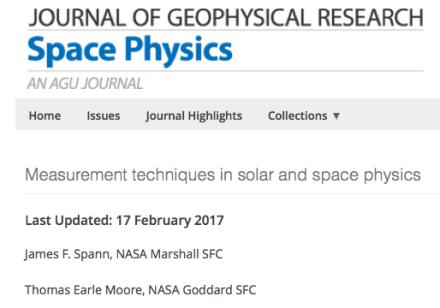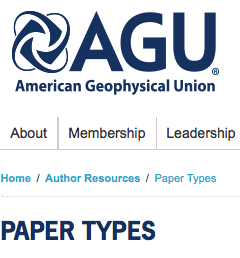During our reviewing and publication of the special sections on Measurement Techniques in Solar and Space Physics,

the JGR Space Physics editors sometimes received questions about the appropriateness of “instrument papers” in this journal. The fact is that JGR Space Physics has accepted Technical Reports: Methods and Technical Reports: Data paper types for many years. The fraction of such papers, though, has been small, with most papers in this journal being the Research Article paper type. When we accepted the proposal for the MTSSP special sections, we knew that reviewing the expected ~150 manuscripts on space instrumentation would be a bit different for those receiving the reviews. It’s not a paper type that we normally get, so some in the space physics community were a little confused about this paper type being in this journal.

I’ve written about the Technical Reports paper type before, but since we’ve reassessed what we want for this paper in JGR Space Physics, it is good to remind the space science community about the expectations for a manuscript in this paper type. The paper must describe a significant original contribution to the field, but this new contribution is the method, technique, or data set. Yes, that’s right: it does not have to include an original contribution to our scientific understanding of the space environment, as is the case for a Research Article paper type. It has to be applicable to scientific study of the space environment, but does not have to actually include such a study.
That said, the manuscript must have these elements:
- A section at the beginning why to I need to study the relevant aspect of space physics. You must motivate the publication of this technical advancement in JGR Space Physics by convincing readers that the science area to which it pertains is interesting.
- A series of clear statements about the novel elements of the method, technique, or data set. You must place the technical advancement in the context of existing technology or data in order to convince readers that the report contains an original and significant contribution in this area.
- A section on what new science is likely to accrue. You must include “at least one illustrative example,” to quote from the paper type description website above. This section closes the gap between the earlier two “must have” sections. That is, given the the current state of scientific discovery in the relevant subdiscipline of space physics and the cutting edge aspects of this new technique or data set, you must then discuss how this new technique will eventually lead to better scientific understanding.
So, authors: if you are writing a Technical Reports manuscript, then please ensure that it includes these three elements.
Also, reviewers: if you are assessing the publishability of a Technical Reports manuscript, please carefully consider these three elements.
AGU has a relatively new journal that is specifically targeted at this manuscript type: Earth and Space Science. Just entering its fourth year, E&SS spans all of AGU’s scientific disciplines, especially requesting papers on “methods, instruments, sensors, data and algorithms” for our field and across the AGU discipline spectrum. I had a recent blog post about signing up for E&SS table of content e-alerts.
A final point to make: Technical Reports paper types are limited to 13 Publication Units rather than the normal 25 for a Research Article paper type. This is to keep the description of the new method, technique, or data set focused. Extra figures and explanation can be put into the online Supplemental Information accompanying the published paper, if needed. You can go over a bit, though and no one should complain or send it back. That is, this limit is not a strict cutoff but is more like a guideline.

Pingback: Space Physics and Aeronomy SPA SECTION NEWSLETTER, Volume XXIV, Issue 22 - Space Physics and Aeronomy